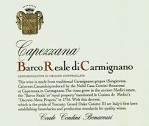Tenuta di Capezzana, Barco Reale di Carmignano DOC (Tuscany, Italy) 2011 (MW Imports, $17): I imagine it can’t be easy making wine in Central Tuscany. On the one hand, you would be part of one of the most scenic, most visited and most famous wine areas in the world — the place where Chianti Classico, Chianti and Brunello di Montalcino are situated. On the other hand, you would compete with many hundreds of other wineries for consumer recognition of your brand and possibly even your historic terroir. Consider the small zone of Carmignano, which overlaps the northern part of the large Chianti zone, just west of Florence: despite its heritage and the fine quality of the wine, how recognizable is the name even among knowledgeable wine lovers?
In the Middle Ages, the territory of Carmignano and its wines were known and respected as distinct from Chianti, and the area officially re-established its identity under Italy’s DOC regulations 45 years ago.  Carmignano’s claim to fame was that, unlike in Chianti, Cabernet grapes have been an historic part of the red wine blend, along with Sangiovese. Today two red wines from the area claim DOC/G recognition: Carmignano DOCG, a blend of at least 50 percent Sangiovese, no more than 20 percent Cabernet Sauvignon and/or Franc, and other grapes, including white grapes optional up to 10 percent, with wood aging obligatory; and Barco Reale di Carmignano DOC, from a similar grape blend for the red version (it can also be rosé or dessert wine –Vin Santo) but without wood aging required.
Carmignano’s claim to fame was that, unlike in Chianti, Cabernet grapes have been an historic part of the red wine blend, along with Sangiovese. Today two red wines from the area claim DOC/G recognition: Carmignano DOCG, a blend of at least 50 percent Sangiovese, no more than 20 percent Cabernet Sauvignon and/or Franc, and other grapes, including white grapes optional up to 10 percent, with wood aging obligatory; and Barco Reale di Carmignano DOC, from a similar grape blend for the red version (it can also be rosé or dessert wine –Vin Santo) but without wood aging required.
This 2011 Barco Reale di Carmignano comes from the Capezzana estate, owned and run for almost a century by the royal Contini Bonacossi family. Tenuta di Capezzana is the flagship producer of the Carmignano zone. The wine’s blend is 70 percent Sangiovese, 15 percent Cabernet Sauvignon, 5 percent Cab Franc, and 10 percent Canaiolo, a native Tuscan red grape. Although regulations don’t require it, one year of aging occurs in oak, specifically French oak; the oak vats are about ten times larger than barriques, however, so that the effect of the wood is to soften the wine more than to contribute aroma and flavor.
This wine strikes a perfect balance between the refreshing drinkability and fruitiness that you expect in an inexpensive wine and the structure and finesse of its pedigree. Its aroma suggests tart red cherries, typical of young Sangiovese, as well as black currants characteristic of Cabernet, with vague accents of fresh herbs. In your mouth, the wine is medium-bodied but solid and well-knit, with a moderate amount of integrated, firm tannin. The acidity is high, which contributes to the impression of freshness and drinkability. The wine’s fresh fruity flavors — darker in your mouth than in the aroma — balance the structure’s tannin-acid combo beautifully: any less tannin-acid, and the wine would be too fruity; any more, and the wine would veer toward austerity. The fruit is concentrated, and carries all the way to a persistent finish.
The 2011 Capezzana Barco Reale di Carmignano is a fine wine from a classic but undervalued wine zone. It’s delightful now and for the next couple of years. I would pair it with salami antipasto, simple chicken or veal dishes, pasta with tomato sauce, or grilled vegetables.
90 Points
